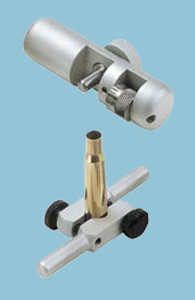- 01: Introduction
- 02: History
- 03: Propellants, Firearms, and Ammunition Development
- 04: Modern Firearms Manufacture
- 05: Small Arms Ammunition
- 06: Evidence Handling Procedures
- 07: Equipment and Instrumentation
- 08: Examination of Firearms
- 09: Cartridge and Shotshell Examination
- 10: Characterization and Evaluation of Fired Projectiles
- 11: Bullet Comparison and Identification
- 12: Gunshot Residue and Distance Determination
- 13: Toolmark Identification
- 14: Communicating Results
- Resources


Reloading and Handloading
Home > Toolmark Identification > Basic Toolmark Identification > Reloading and Handloading

Case turning tool
The processes involved in reloading and handloading ammunition produce toolmarks of a specialized type on ammunition components. In reloaded ammunition the marks are not the result of the discharge of a firearm. The action of the steel tools of a reloading press on the softer components of metallic ammunition may produce striated or impressed marks that can reflect class, subclass, and individual characteristics. The marks may potentially be reproduced, compared, and identified with a particular reloading tool.
The process of identification of toolmarks produced by reloading tools is parallel to other toolmark identifications in that they include the following:
- Characteristics that may be class, subclass, or individual
- Pattern identification
- AFTE Theory of Identification as it Relates to Toolmarks
- Principle of sufficient agreement
- Principle of consecutive matching striae
- AFTE Range of Conclusions
In general, the most useful toolmarks produced by reloading equipment fall into two categories:
- Cartridge case marks
- Holding tools on a reloading press which grips the base of cartridge cases
- Resizing tools (e.g., sizing die) which squeeze fired cases back to their original specifications
- Crimping tools used for some loads to press the mouth of cases slightly into a cannelure used as a crimping groove
- Bullets bearing bullet-seating toolmarks




